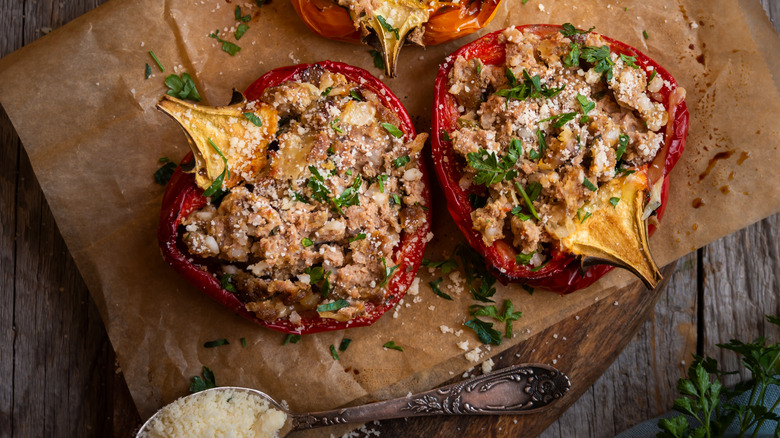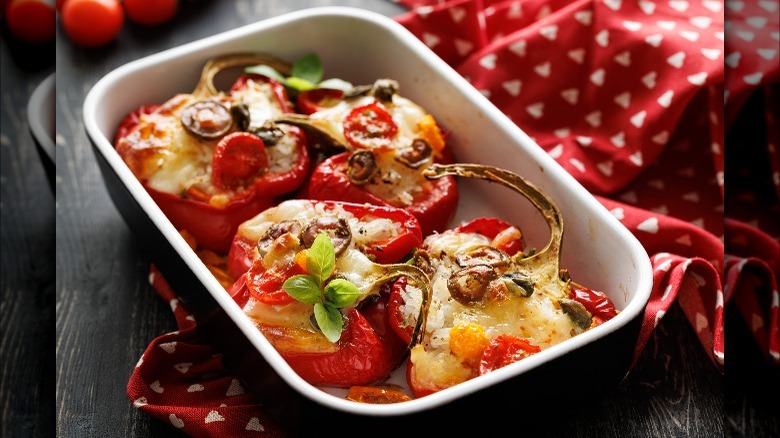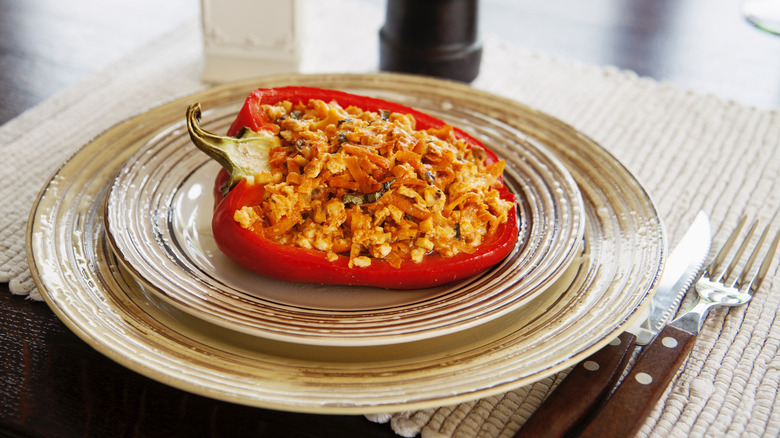What's The Best Method For Reheating Stuffed Peppers?
Stuffed peppers are a perfect at-home hearty meal that is also versatile. One of the most common ways of preparing them is stuffing the peppers with ground beef. However, you can swap that out for chicken or ground turkey or forego the meat altogether and opt for a vegetarian take with extra rice, mushrooms, and other veggies.
The delectable dish is fit for a king or queen. Former royal chef Darren McGrady, who cooked for the royal family for 15 years, states that stuffed peppers were one of Princess Diana's favorite meals. Speaking about his experiences in the kitchen with the royal family to The Huffington Post, McGrady shared a version of stuffed peppers he used to prepare for Diana. Those peppers were stuffed with onion, mushrooms, zucchini, tomatoes, and chopped crispy bacon bits for flavor and texture. According to McGrady, he would cook stuffed peppers for Princess Di around two to three times a week, as he told Delish. His healthy peppers were one of her go-to dishes.
Regardless of your choice of meat or whether you want vegetarian stuffing, stuffed peppers are delicious reheated. After cooking your peppers, put the leftovers in a sealable container such as a large Tupperware. They will keep in the fridge for up to four days. Wrap the container in plastic wrap and place it in the freezer to keep them for up to three months. When you are ready to enjoy your leftovers, there is one way of reheating them that is tastier than the rest.
The best way to retain the texture of your stuffed peppers
To best recapture that freshly-cooked taste, take the extra time to place leftover stuffed peppers in the oven. It does take longer than other methods, but reheating in the oven will help the peppers retain their texture and that outer crispiness. Plus, if the peppers were frozen, putting them in the oven allows them to cook through. Preheat the oven to 350 degrees, and place the peppers in a casserole dish with a lid or cover with aluminum foil. Make sure the peppers are spaced out when lining the dish. Do not stack them. Bake them for 15 to 20 minutes. Take the casserole dish out and remove the lid, then place the peppers back in the oven for five minutes to achieve a crispy finish. Check the internal temperature of the peppers, as it should be around 165 degrees.
If the peppers were frozen and not thawed, they will take longer to reheat at around 30 minutes. You can cut down on the cooking time by placing the peppers in the microwave for 20 seconds or further reduce the wait by slicing the peppers in half.
To reheat one pepper, wrap the pepper with foil. Place the pepper on a cooking tray to catch any potential spillage. Other reheating methods may be quicker, but they are not as tasty.
Why reheating in an air fryer could be risky
Waiting for the oven to preheat and for the stuffed peppers to cook may be too time-consuming for impatient eaters. Microwaving the peppers is the quickest method, but be sure to cover the peppers with a damp paper towel to keep them from drying out. Microwave the peppers for two minutes, and repeat at 10 to 15-second intervals if needed.
Although it takes nearly as long as using an oven, an air fryer is another alternative to heat your leftover peppers. Place them in the fryer basket and cook at 350 degrees for 15 to 20 minutes. This may only be slightly faster than the oven, but the air fryer has the bonus of giving the edges a great, crispy texture. Be warned, however, that an air fryer should only be used if the peppers are moist, as you could be left with dried-out peppers if they were on the dryer side, to begin with.
One major advantage of reheating leftovers is that it gives you extra time to prepare a side dish which can be made while the peppers reheat. This could be the time to get your greens in by adding side dishes such as arugula salad, sauteed green beans, or stir-fried spinach.


